Linden D., Reddy T.B. (eds.) Handbook of batteries
Подождите немного. Документ загружается.


25.2 CHAPTER TWENTY-FIVE
TABLE 25.1 Iron Electrode Battery Systems
System Uses Advantages Disadvantages
Iron/ nickel oxide
(tubular)
Material handling
vehicles, underground
mining vehicles,
miners’ lamps, railway
cars and signal
systems, emergency
lighting
Physically almost
indestructible
Not damaged by
discharged stand
Long life, cycling or
stand
Withstands electrical
abuse: overcharge,
overdischarged,
short-circuiting
High self-discharge
Hydrogen evolution on
charge and discharge
Low power density
Lower energy density
than competitive
systems
Poor low-temperature
performance
Damaged by high
temperatures
Higher cost than lead-acid
Low cell voltage
Iron/ air Motive power Good energy density
Uses readily available
materials
Low self-discharge
Low efficiency
Hydrogen evolution on
charge
Poor low-temperature
performance
Low cell voltage
Iron/ silver oxide Electronics High energy density
High cycle life
High cost
Hydrogen evolution on
charge
TABLE 25.2 System Characteristics
System
Nominal voltage, V
Open-circuit Discharge
Specific
energy
Wh/kg
Energy
density
Wh/L
Specific
power
W/kg
Cycle life,
100%
DOD
Iron/ nickel oxide
Tubular 1.4 1.2 30 60 25 4000
Developmental 1.4 1.2 55 110 110
⬎1200
Iron air 1.2 0.75 80 60 1000
Iron/ silver oxide 1.48 1.1 105 160 —
⬎300
25.2 CHEMISTRY OF NICKEL-IRON BATTERIES
The active materials of the nickel-iron battery are metallic iron for the negative electrode,
nickel oxide for the positive, and a potassium hydroxide solution with lithium hydroxide for
the electrolyte. The nickel-iron battery is unique in many respects. The overall electrode
reactions result in the transfer of oxygen from one electrode to the other. The exact details
of the reaction can be very complex and include many species of transitory existence.
2–4
The
electrolyte apparently plays no part in the overall reaction, as noted in the following reac-
tions:
discharge
—— —
Fe ⫹ 2NiOOH ⫹ 2H O 2Ni(OH) ⫹ Fe(OH) (first plateau)
———
2
22
charge
discharge
—— —
3Fe(OH) ⫹ 2NiOOH 2Ni(OH) ⫹ Fe O ⫹ 2H O (second plateau)
———
2
234 2
charge
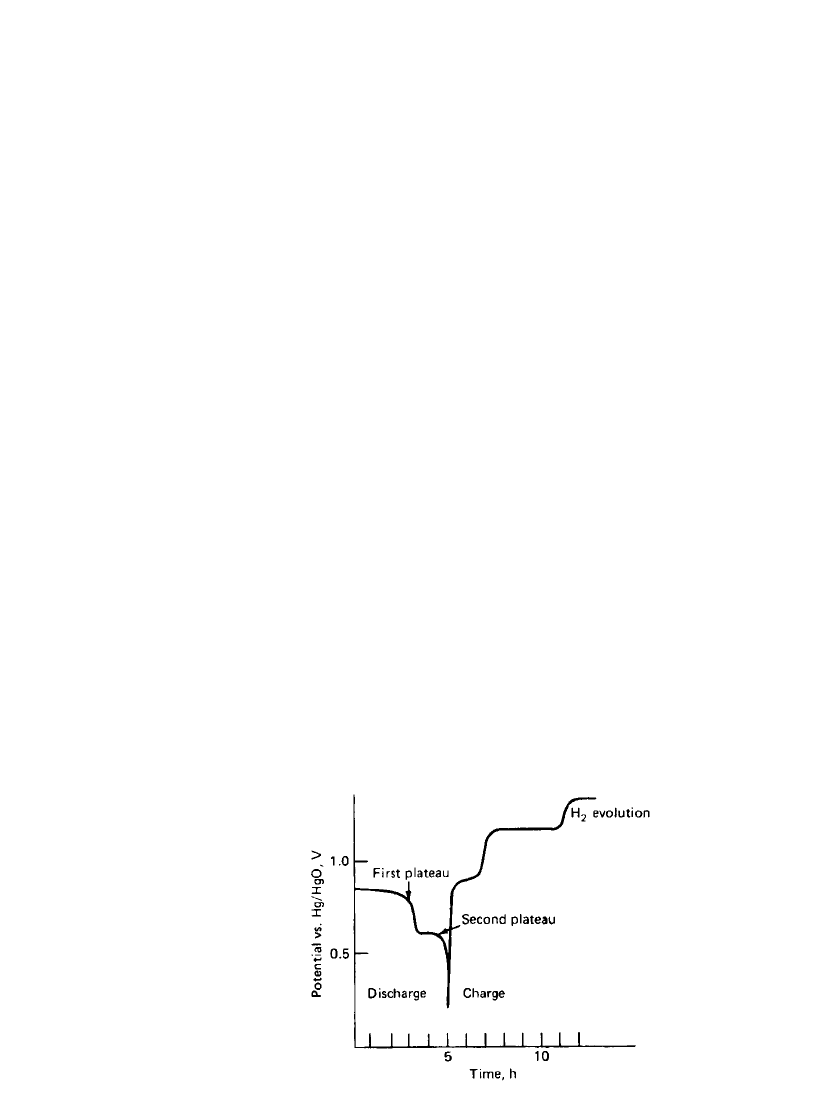
IRON ELECTRODE BAT TERIES 25.3
FIGURE 25.1 Discharge-charge curve of an iron
electrode. (From Ref. 5.)
The overall reaction is
discharge
—— —
3Fe ⫹ 8NiOOH ⫹ 4H O 8Ni(OH) ⫹ Fe O
———
2
234
charge
The electrolyte remains essentially invariant during charge and discharge. It is not possible
to use the specific gravity of the electrolyte to determine the state of charge as for the lead-
acid battery. However, the individual electrode reactions do involve an intimate reaction with
the electrolyte.
A typical charge-discharge curve of an iron electrode is shown in Fig. 25.1. The two
plateaus on charge correspond to the formation of the stable
⫹2 and ⫹3 valent states of the
iron reaction products. The reaction of the iron electrode can be written as
⫺
2
⫺
n
Fe ⫹ nOH → FE(OH) ⫹ 2e (first plateau)
n
and
2
⫺
n
⫺
Fe(OH) → Fe(OH) ⫹ nOH
n 2
⫺
Fe(OH) ⫹ OH → Fe(OH) ⫹ e (second plateau)
23
Then
2Fe(OH)
⫹ Fe(OH) → Fe O ⫹ 4H O
32342
Iron dissolved initially as the ⫹2 species in alkaline media. The divalent iron complexes
with the electrolyte to form the complex of low solubility. The tendency to
2
⫺
n
Fe(OH)
n
supersaturate plays an important role in the operation of the electrode and accounts for many
important aspects of the electrode performance characteristics. Continued charge forms the
⫹3 valent iron which, in turn, interacts with ⫹2 valent iron to form Fe
3
O
4
.

25.4 CHAPTER TWENTY-FIVE
The superior life-cycling characteristics of the iron electrode result from the low solubility
of the reaction intermediates and oxidized species. The supersaturation on discharge results
in the oxidized material forming small crystallites near the reaction site. On charge, the low
solubility also slows the crystal growth of the iron, thereby helping to ensure formation of
the original active high-surface-area structure. The low solubility also accounts for poor high-
rate and low-temperature performance as the discharged (oxidized) species precipitate at or
near the reaction site and block the active surface. The performance characteristics are sub-
stantially improved, however, in the advanced nickel-iron batteries by the use of a superior
electrode grid structure, such as fiber-metal, which provides intimate contact with the iron
active material throughout the volume of porous structure.
Sulfide addition to the iron electrode radically changes the electrocrystallization kinetics.
It increases the supersaturation and makes reaction more reversible. Sulfide also absorbs on
the surface to block crystallization sites and raises the hydrogen evolution reaction on charge.
Lithium salt additions seem to make the electrode perform more reversibly, perhaps by
enhancing the solubility of the reaction intermediates.
Nickel electrode reactions
6,7
are generally thought to be solid-state-type reactions wherein
a proton is injected or rejected from the lattice reversibly on discharge and on charge,
respectively.
transformation
————

-Ni(OH) ←
␣
-Ni(OH)
22
in KOH
reduction oxidation oxidation reduction
(discharge) (charge) (charge) (discharge)
overcharge
———

-NiOOH →
␥
-NiOOH
in KOH
The oxidation (charge) voltage for the
␣
and

materials is more positive than the dis-
charge voltage by 60 mV and 100 mV, respectively. The

-Ni(OH)
2
is the usual electrode
material. It is converted on charge to

-NiOOH with about the same molar volume. On
overcharge the
␥
structure can form. This form also incorporates water and potassium (and
lithium) into the structure. Its molar volume is about 1.5 times the

form. This is thought
to be responsible in large part for the volume expansion (swelling) which occurs on charging
the battery. The
␣
form then results on discharge of the
␥
form. Its molar volume is about
1.8 times the

form, and the electrode can swell further on discharge. On discharge stand
in concentrated electrolyte, the
␣
form converts to the

form. Cobalt additions (2 to 5%)
improve the charge acceptance (reversibility) of the nickel electrode.
25.3 CONVENTIONAL NICKEL-IRON BATTERIES
25.3.1 Construction
The construction of a tubular or pocket plate nickel-iron cell is shown in Fig. 25.2. The
active materials are filled in nickel-plate perforated steel tubes or pockets. The tubes are
fastened into plates of desired dimensions and assembled into cells by interleaving the pos-
itive and negative plates. The container is fabricated from nickel-plated sheet steel. The cells
may be assembled into batteries in molded nylon cases or mounted into wooden traps. The
steel cases may be coated with plastic or rubber for insulation or spaced by insulating buttons.
The manufacturing process has remained relatively unchanged for over 50 years. The
processes are designed to produce materials of highest purity and with special particle char-
acteristics for good electrochemical performance.

IRON ELECTRODE BAT TERIES 25.5
FIGURE 25.2 Cross section of typical nickel-
iron battery. (Courtesy of SAFT America, Inc.)
Negative Electrode. To produce the anode active material, pure iron is dissolved in sulfuric
acid. The FeSO
4
is recrystallized, dried, and roasted (815 to 915⬚C) to Fe
2
O
3
. The material
is washed free of sulfate, dried, and partially reduced in hydrogen. The resulting material
(Fe
3
O
4
and Fe) is partially oxidized, dried, ground, and blended. Small amounts of additives,
such as sulfur, FeS, and HgO, are blended in to increase battery life by acting as depassi-
vators, reducing gas evolution, or improving conductivity.
To make the anode current collector, steel strips or ribbon are perforated and nickel-
plated. After drying and annealing, the strip is formed into a pocket, about 13 mm wide and
7.6 mm long. One end is left open and filled with the iron active material. A machine
automatically introduces the active material and tamps it into the pockets. After filling, the
negative pockets are crimped and pressed into openings in a nickel-plated steel frame.
Positive Electrode. The positive active material consists of nickel hydroxide in alternate
layers with nickel flake. High-purity nickel powder or shot is dissolved in sulfuric acid. The
hydrogen evolved is used in making the iron active material. The acidity of the resulting
solution is adjusted to pH 3 to 4 and filtered to remove ferric iron and other insoluble
materials. If needed, the solution may be further purified to remove traces of ferrous iron

25.6 CHAPTER TWENTY-FIVE
and copper. Cobalt sulfate may be added in the proportion of 1.5% to improve nickel elec-
trode performance. The nickel sulfate solution is sprayed into hot 25 to 50 NaOH solution.
The resulting slurry is filtered, washed, dried, crushed, and screened to yield particles which
pass 20- but not 200-mesh screens.
Special nickel flake (1.6
⫻ 0.01 mm) is produced by electrodepositing alternate layers of
nickel and copper on stainless steel. The electroplate is stripped and cut into squares. The
copper is dissolved out in hot sulfuric acid, and the resulting nickel flakes are washed free
of copper and dried at low temperature to prevent nickel oxide formation. With a modified
process
8
the flakes of proper shape and size can be produced as a single layer, eliminating
the need for deposition of alternate copper layers. As in the negative electrode, the positive-
electrode process starts with perforated steel ribbon which is nickel-plated and annealed. The
ribbon is wound into tubes with an interlocked seam. Two types, right- and left-wound tubes,
are produced, typically of 6.3-mm diameter. The tubes are filled with alternate layers of
nickel hydroxide and nickel flakes. Each layer is tamped (144 kg /cm
2
) to ensure good
contact. There are 32 layers of flake per centimeter. To prevent the seam from opening during
the rigors of charge and discharge, rings are placed around the tubes at uniform intervals of
about 1 cm. The tubes are enclosed, and the pinched ends are locked into the nickel-plated
steel grid frame. The ‘‘rights’’ and ‘‘lefts’’ are alternated so that any tendency to distort on
the part of one tube is counteracted by the next one. The positive electrode can also be made
in the pocket plate construction, as described above under ‘‘Negative Electrode.’’
Cell Assembly. The configuration and size of the tubes and pockets determine the capacity
for each plate. The plates are then assembled into electrodes to meet the capacity require-
ments of each cell.
Each plate group is assembled by bolting a terminal pole and a selected number of plates,
depending on capacity, to a steel rod which passes through the grid at the top of the plates.
Groups of positive and negative plates are intermeshed to form the element. A cell usually
contains one or more negative than positive plates. The cells are made positive limiting for
best cycle life.
The positive and negative plates are separated by hard rubber or plastic pins called ‘‘hair
pins’’ or ‘‘hook pins,’’ which fit into spaces formed by the tubular positive and flat negative
electrodes.
Electrolyte. The electrolyte is a 25 to 30% KOH solution with up to 50 g/L of LiOH
added. The composition of the replacement electrolyte to compensate for losses due to spray
from the vent cap is about 23% caustic with about 25 g/ L LiOH. Occasionally the electrolyte
is replaced completely to rejuvenate the cell performance. The renewal electrolyte is about
30% KOH with 15 g /L LiOH.
Lithium additions to the electrolyte are important but not completely understood. Lithium
hydroxide improves cell capacity and prevents capacity loss on cycling and also seems to
facilitate nickel electrode kinetics. It expands the working plateau on charge and delays
oxygen evolution. Some evidence exists for the formation of Ni
4
⫹
, which improves electrode
capacity. Lithium also decreases the carbonate content in the electrolyte since Li
2
CO
3
is not
very soluble. It also decreases the tendency for swelling of the positive active material but
increases the resistivity of the cell electrolyte.
Shortly after initiation of charge, hydrogen evolution begins on the iron electrode. The
considerable hydrogen evolution on charge presumably helps counteract iron passivation in
alkaline solution. Mercury additions also have a similar effect, but only in the early formation
cycles.
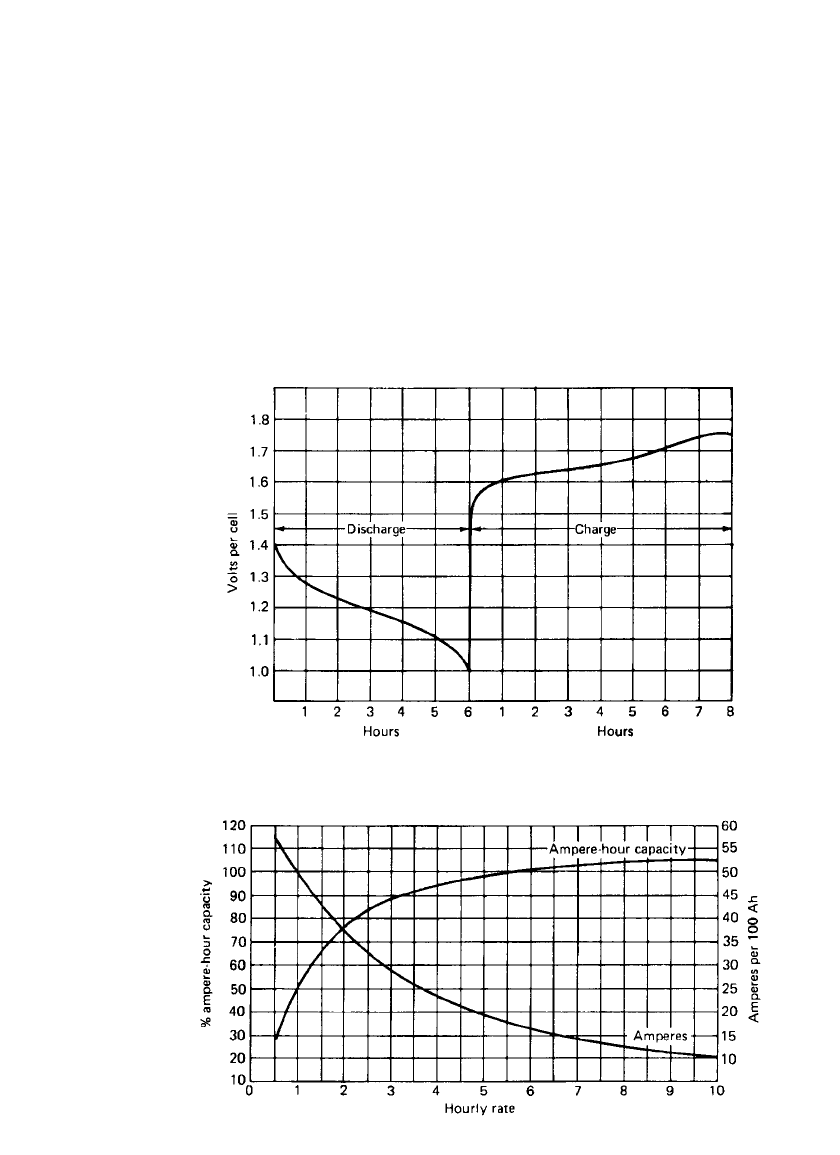
IRON ELECTRODE BAT TERIES 25.7
25.3.2 Performance Characteristics of Nickel-Iron Battery
Voltage. A typical discharge-charge curve of a commercial iron/ nickel oxide battery is
shown in Fig. 25.3. The battery’s open-circuit voltage is 1.4 V; its nominal voltage is 1.2 V.
On charge, at rates most commonly used, the maximum voltage is 1.7 to 1.8 V.
Capacity. The capacity of the nickel-iron battery is limited by the capacity of the positive
electrode and, hence, is determined by the length and number of positive tubes in each plate.
The diameter of the tubes generally is held constant by each manufacturer. The 5-h discharge
rate is commonly used as the reference for rating its capacity.
The conventional nickel-iron battery has moderate power and energy density and is de-
signed primarily for moderate to low discharge rates. It is not recommended for high-rate
applications such as engine starting. The high internal resistance of the battery lowers the
terminal voltage significantly when high rates are required. The relationship between capacity
and rate of discharge is shown in Fig. 25.4.
FIGURE 25.3 Typical voltage characteristics during constant-rate discharge
and recharge. (From Ref. 9.)
FIGURE 25.4 Curves of capacity vs. discharge rate at 25⬚C; end voltage 1.0 V per
cell. (From Ref. 9.)
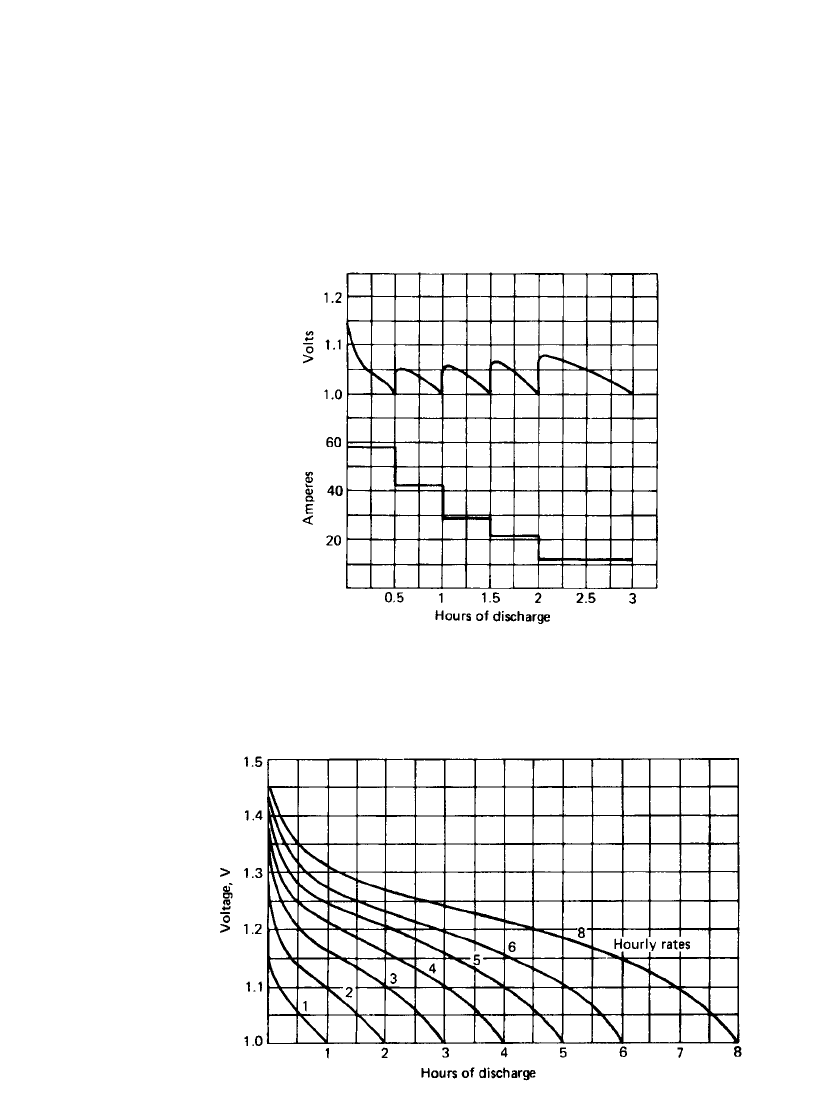
25.8 CHAPTER TWENTY-FIVE
FIGURE 25.5 Effect of decreasing rate on battery
voltage of nickel-iron cell.
FIGURE 25.6 Time-voltage discharge curves of nickel-iron battery; end volt-
age 1.0 V per cell. (From Ref. 9.)
If a battery is discharged at a high rate and then at a lower rate, the sum of the capacities
delivered at the high and low rates nearly equals the capacity that would have been obtained
at the single discharge rate. This is illustrated in Fig. 25.5.
Discharge Characteristics. The nickel-iron battery may be discharged at any current rate
it will deliver, but the discharge should not be continued beyond the point where the battery
nears exhaustion. It is best adapted to low or moderate rates of discharge (1- to 8-h rate).
Figure 25.6 shows the discharge curves at different rates of discharge at 25
⬚C.
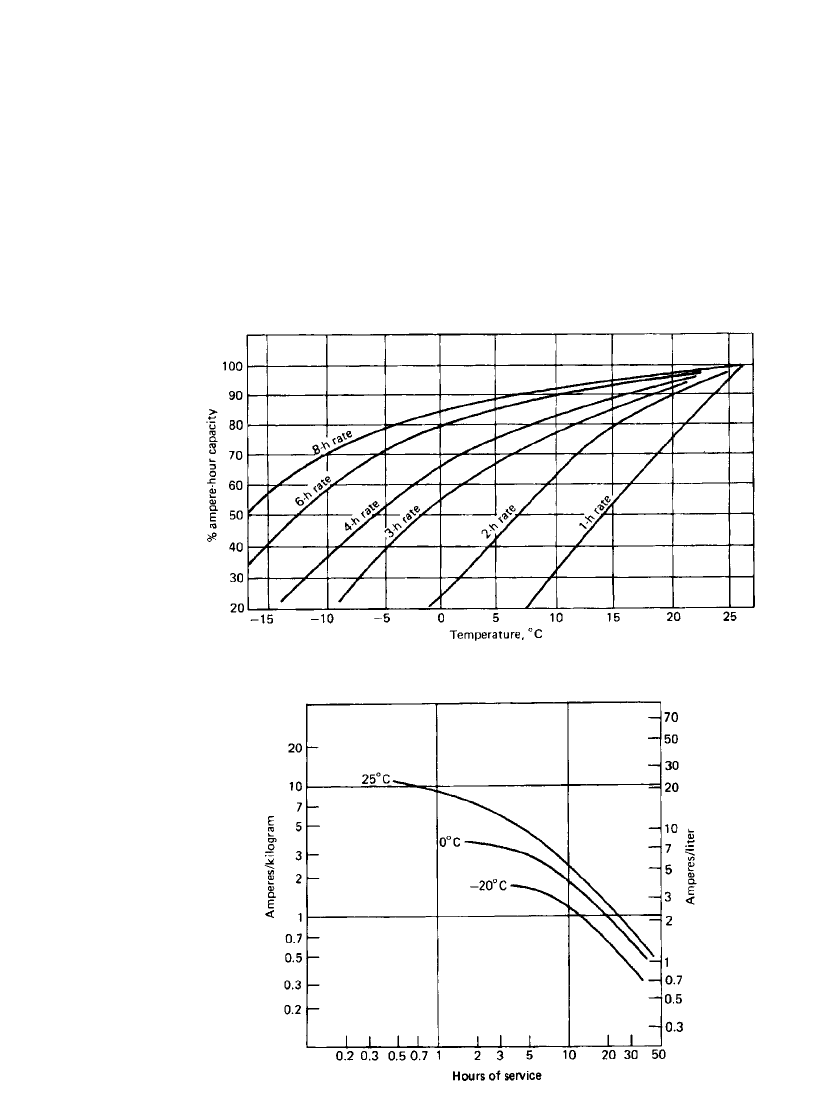
IRON ELECTRODE BAT TERIES 25.9
Effect of Temperature. Figure 25.7 shows the effects of temperature on the discharge. The
capacity at 25
⬚C is normally taken as the standard reference value. The decrease in perform-
ance is generally attributed to passivity of the iron electrode and decreased solubility of the
reaction intermediate. At low temperature, increased resistivity and viscosity of the electro-
lyte along with slower nickel electrode kinetics contribute to the fall-off of capacity. Care
must be exercised to keep the temperature from exceeding about 50
⬚C as the self-discharge
of the nickel positive electrode is accelerated. Also, the increased solubility of iron at high
temperature can adversely affect operation of the nickel electrode by incorporating soluble
iron into the nickel hydroxide crystal lattice. The battery is seldom used below
⫺15⬚C.
Hours of Service. The hours of service on discharge that a typical nickel-iron battery,
normalized to unit weight (kilograms) and volume (liters), will deliver at various discharge
rates and temperatures is summarized in Fig. 25.8.
FIGURE 25.7 Effect of temperature on capacity at various rates. (From Ref. 9.)
FIGURE 25.8 Hours of service of nickel-iron battery at various
discharge rates and temperatures; end voltage 1.0 V cell.
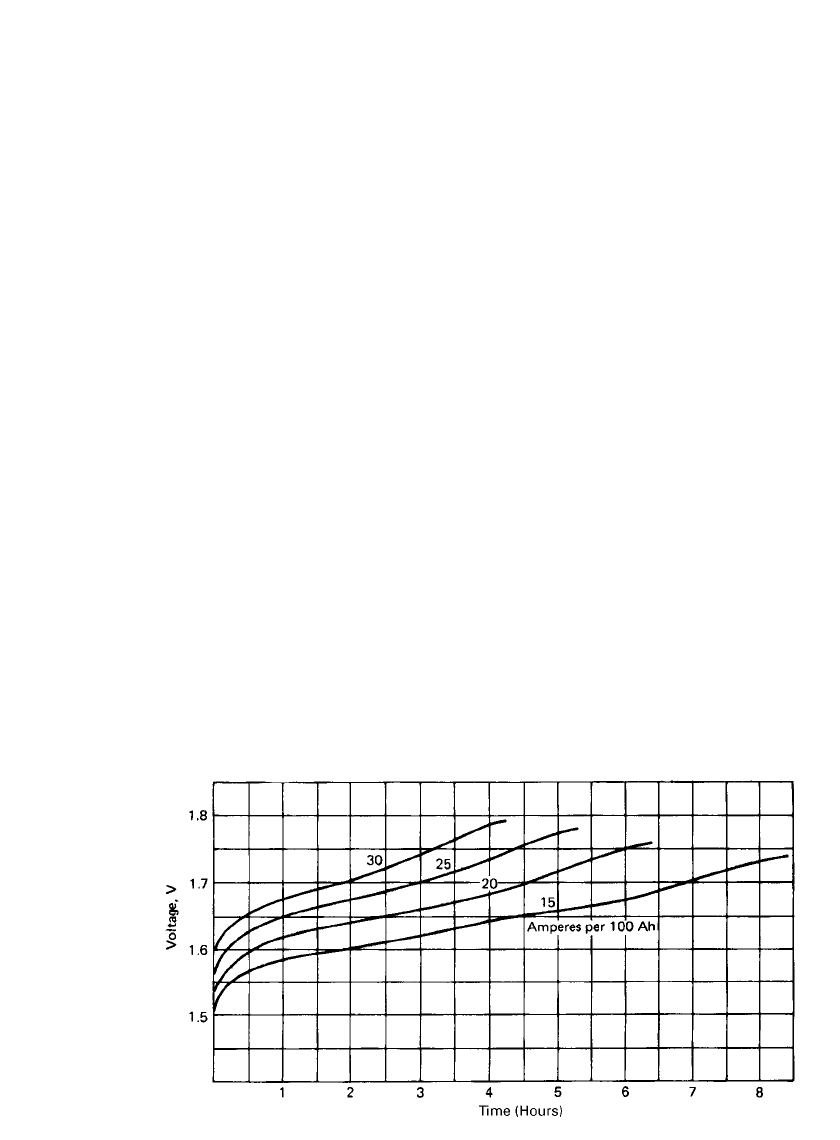
25.10 CHAPTER TWENTY-FIVE
FIGURE 25.9 Typical charging voltage for nickel-iron battery at various rates. (From Ref. 9.)
Self-Discharge. The self-discharge rate, charge retention, or stand characteristic of the
nickel-iron battery is poor. At 25
⬚C a cell will lose 15% of its capacity in the first 10 days
and 20 to 40% in a month. At lower temperatures the self-discharge rate is lower. For
example, at 0
⬚C the losses are less than one-half of those experienced at 25⬚C.
Internal Resistance. To a rough approximation, the internal resistance R
i
can be estimated
for tubular Ni-Fe from the equation
R
⫻ C ⫽ 0.4
i
where R
i
⫽ internal resistance, ⍀
C ⫽ battery capacity, Ah
For example, R
i
⫽ 0.004 ⍀ for a 100-Ah battery. The value of R
i
remains constant through
the first half of the discharge, then increases about 50% during the latter half of the discharge.
Life. The main advantages of the tubular-type nickel-iron battery are its extremely long
life and rugged construction. Battery life varies with the type of service but ranges from 8
years for heavy duty to 25 years or more for standby or float service. With moderate care,
2000 cycles can be expected; with good care, for example, by limiting temperatures to below
35
⬚C, cycle life of 3000 to 4000 cycles has been achieved.
The battery is less damaged by repeated deep discharge than any other battery system.
In practice, an operator will drive a battery-operated vehicle until it stalls, at which point
the battery voltage is a fraction of a volt per cell (some cells may be in reverse). This has
a minimal effect on the nickel-iron battery in comparison with other systems.
Charging. Charging of the batteries can be accomplished by a variety of schemes. As long
as the charging current does not produce either excessive gassing (spray out of the vent cap)
or temperature rise (above 45
⬚C), any current can be used. Excessive gassing will require
more frequent addition of water. If the cell voltage is limited to 1.7 V, these conditions
should not be a consideration. Typical charging curves are given in Fig. 25.9. The Ampere-
hour input should return 25 to 40% excess of the previous discharge to ensure complete
charging. The suggested charge rate is normally between 15 and 20 A per 100 Ah of battery
capacity. This rate would return the capacity in the 6- to 8-h time frame. The effect of
temperature on charging is shown in Fig. 25.10.
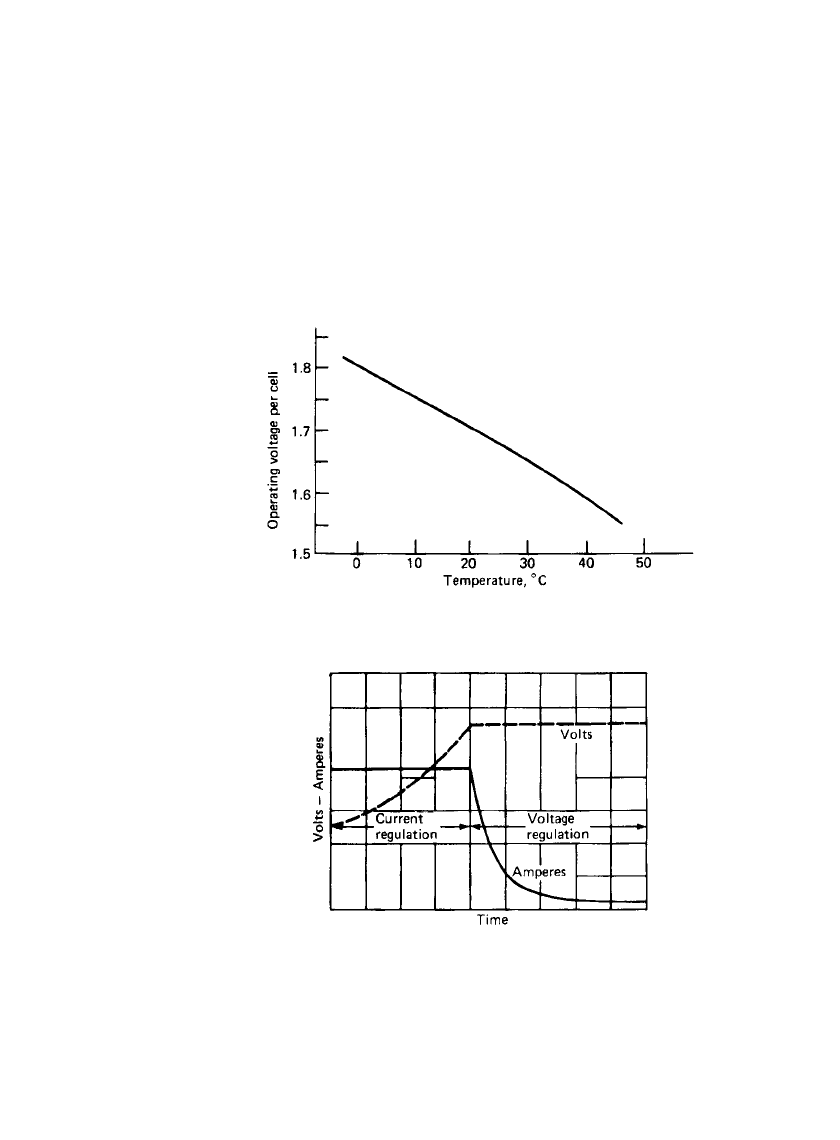
IRON ELECTRODE BAT TERIES 25.11
Constant current and modified constant potential (taper), shown in Fig. 25.11, are common
recharging techniques. The charging circuit should contain a current-limiting device to avoid
thermal runaway on charge. Recharging each night after use (cycle charging) is the normal
procedure. The batteries can be trickle-charged to maintain them at full capacity for emer-
gency use. A trickle charge rate of 0.004 to 0.006 A /Ah of battery capacity overcomes the
internal self-discharge and maintains the battery at full charge. Following an emergency
discharge, a separate recharge is needed. For applications such as railroad signals, charging
at a continuous average current may be the most economic method. Here a modest drain is
required when no trains are passing but quite a heavy drain when a train passes, yet the total
Ampere-hours over a period of 24 h remains fairly constant. For this situation, a constant
current equal to that required to maintain the battery can be used.
FIGURE 25.10 Variation of relay operating voltage with tem-
perature. (From Ref. 9.)
FIGURE 25.11 Effects of ‘‘regulators’’ with volt-
age and current regulation. (From Ref. 9.)
25.3.3 Sizes of Nickel-Iron Batteries
Nickel-iron batteries have been available in sizes ranging from about 5 to 1250 Ah. In recent
years they have become less popular, giving way to the lead-acid and nickel-cadmium bat-
teries, and are no longer manufactured by many of the original manufacturers. Table 25.3
lists the physical and electrical characteristics of typical nickel-iron batteries.
